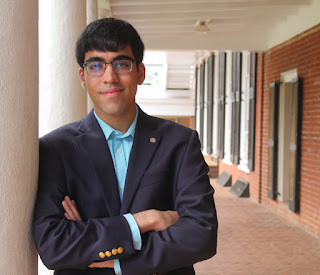 |
Jude Fairchild, Graham Lenert and Iya Feggans
are all studyingengineering with Brendan Martin at Buford. / Photo: Marguerite Gallorini
|
Increasingly, Virginia schools are getting financial support to seek a more diverse population in STEM programs -- that's science, technology, engineering and math. In Charlottesville, grants are funding a partnership between Piedmont Virginia Community College, the University of Virginia and Buford Middle School to make that dream come true. WMRA’s Marguerite Gallorini has this report.
Let’s start with Piedmont Virginia Community College – their goal is to use $170,000 in grant money to build a pipeline of underrepresented students in STEM programs. The money comes from the Virginia-North Carolina Alliance, a consortium of 12 institutions, including historically black colleges and universities.
JOANNA VONDRASEK: At least historically with this grant, it has been African-Americans, Hispanic students, and Native Americans and Pacific Islanders. We're also looking to increase the number of women in the engineering degree as well.
That’s Joanna Vondrasek, a professor of biology and the college site coordinator for this grant.
VONDRASEK: We have a lot of first-generation college students as well who don't fit necessarily the demographic of traditionally under-represented minorities. However, first-generation students of all backgrounds have generally a harder time making it through college than folks who have parents who went to college. And so I feel like all of this support has helped our students across the board.
The grant allows PVCC to reinforce funding for more resources such as tutors in a few core classes, take students to conferences, and build up their course called Science 299.
VONDRASEK: If a student is interested in transferring to a 4-year school as a chemistry major, they would complete a chemistry capstone research project - biology, physics, geology are offered as well. So the students are designing and then implementing their own experiment doing data analysis and then at the end of the semester they're presenting their work in a mini-scientific conference that we hold on campus.
This gives students a head start when they want to transfer to a four-year school such as the University of Virginia. UVa actually leads this project funded by the National Science Foundation (NSF) and asked PVCC to join.
JOHN GATES: It's a natural partner for us. Piedmont produces great students. We know that the majority of underrepresented students and women, in fact, start their educational careers at community colleges.
John Gates is the Associate Dean for Diversity and Inclusion in the School of Engineering and Applied Science at UVa. He says this kind of STEM funding really benefits the whole nation.
GATES: We're in this real period of change in America, in 25 years from now America will be majority minority. The National Science Foundation and the Department of Defense have declared that the paucity of underrepresented scholars in engineering is, in fact, a national security threat to the nation. We are not producing enough engineering scholars to meet the growing and more complex needs of our nation.
To help meet those needs, UVa also recently received a $15 million grant from the Clark Foundation - and was able to match it dollar for dollar to make a total of $30 million. Besides college, these grants are also helping to reach into secondary schools, including summer classes for high school students.
GATES: We have a great partnership with Albemarle County High School and the schools generally, as well as Charlottesville high schools. We provide summer programs for high school students every summer, and bring quite a number onto Grounds - I think last summer we had over a hundred underrepresented students from the high schools both in Virginia and nationally here doing the study and research. We work in partnership with a middle school just around the corner from here that has a majority minority population.
[Children at school]
That school is Buford Middle School. Engineering teacher Brendan Martin is a former UVa graduate student in Systems Engineering.
BRENDAN MARTIN: I think engineering is an awesome opportunity for kids where they can not only just learn the content of engineering and science but also how to learn and how to problem-solve effectively and how to be resourceful when they're given really challenging tasks.
Buford Middle School’s curriculum is based on UVa’s Laboratory School for Advanced Manufacturing; Buford also has an after-school club meeting every Monday, as well as a partnership with the IT giant Cisco with credentials integrated into the school's curriculum. One opportunity for the middle school students is using a program called Solidworks, a professional design tool used by major engineering companies. That’s what young Iya Feggans is doing.
IYA FEGGANS: I'm working on Solidworks right now - it's like where you have to make these different parts and then at the end, you put them all together on the computer, and I'm on part 6 right now, and it's fun but it can be super hard. But it's nice when you finish it, and the feeling of it.
Last year, Charlottesville City Schools sought to reach even younger students.
MARTIN: We have this great program from 7 to 12 now - from Buford all the way to CHS, we offer engineering 1 through 5 - but what we found is "Wait, we really want to get kids interested and involved in this earlier, and we need to get kids ready for 7th grade engineering." So we built out what's called the iSTEM program which is placing teachers in all the elementary schools and at the upper elementary school, to do some of these STEM activities, to engage them.
What’s the ultimate obstacle to these kids’ success? According to young Jude Fairchild from Buford, it’s only himself.
JUDE FAIRCHILD: The only barrier I really have is if I don't try. I can reach my goals, I can reach my potential if I work hard enough.






